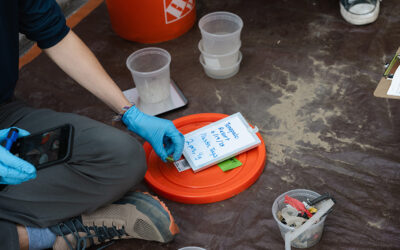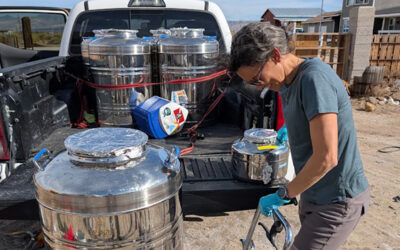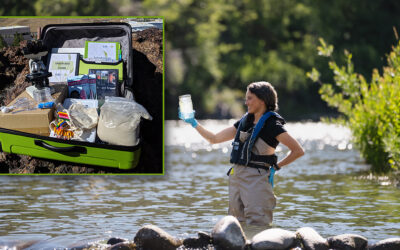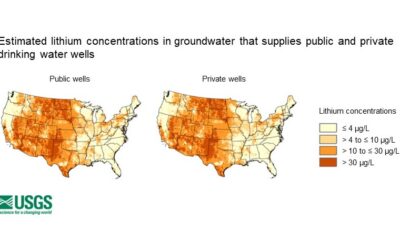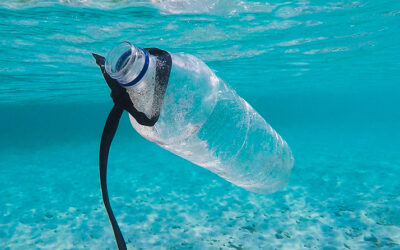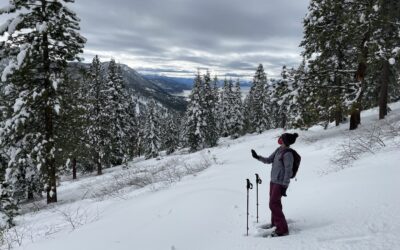An examination of Rocky Mountain snow finds higher contamination levels of mercury and others metals in the northern part of the range, consistent with increased current and historical mining in the region. The study, published in the May issue of the journal Environmental Pollution, examined contamination levels for Mercury, Zinc, Cadmium and Antimony from nearly 50 sites in the Rocky Mountains.
Blurring the Line Between Rain and Snow: The Limits of Meteorological Classification
A new study published in Nature Communications utilizes insights gleaned from DRI’s Mountain Rain or Snow project to evaluate why traditional weather forecasting struggles to identify the rain/snow transition line. The research was possible because thousands of community members across the U.S. contributed more than 40 thousand observations of the type of precipitation falling at their location.
Volunteer Scientists Validate Rain and Snow Estimates
DRI scientists Guo Yu, Meghan Collins, Monica Arienzo, and Anne Heggli co-authored a new study that examines how Mountain Rain or Snow is helping improve weather forecasting models. The citizen science project collects observations of precipitation from community volunteers across the country to further scientific understanding of the environmental variables impacting where precipitation falls as either rain or snow. This information is critical for informing avalanche forecasting, road safety, and water resources management.
DRI Internships Offer Nevada Students Experience with Research and Insight into STEM Careers
This summer and fall, DRI brought twelve students from Nevada’s community and state colleges to the Las Vegas and Reno campuses for a paid, immersive research experience. Over the course of the 16-week program, students worked under the mentorship of DRI faculty members to learn about the process of using scientific research to solve real-world problems. This unique internship program welcomes all students, not only those pursuing majors in science, who are in their first or second year of enrollment at local state and community colleges.
DRI Recruiting Fallon Community Members for Free Well Water Quality Testing
DRI scientists are recruiting fifteen Fallon residents with private wells to participate in a water quality study. All fifteen study participants will receive free water quality results, and a subset of the well owners will receive water filtration systems. The research will be used to identify the spatial extent and potential sources of contaminants such as pesticides, microplastics, and flame retardants and quantify the efficacy of treatment systems to reduce concentrations in drinking water.
DRI’s STEM Education Team Receives EPA Grant to Support Microplastics Education for Nevada Students and Communities
The $100,000 grant will fund the production of additional educational kits known as Greenboxes that raise awareness and understanding of the prevalence and role of microplastics in the environment. In addition to the Greenboxes, the grant will also support community partnerships with The Nature Conservancy, the Walker Basin Conservancy, Get Outdoors Nevada, Sierra Nevada Journeys, and Envirolution.
River ‘Plastisphere’ Serves as Home to Ecosystem-Draining Organisms
New research explores the microbial communities that live on plastic waste and how they impact the 2nd most biodiverse river in the world. DRI researchers Monica Arienzo and Rachel Kozloski are co-authors on this new study that examines the ecological impacts of plastic waste in Cambodia’s Mekong River.
New Study Estimates Lithium in Groundwater That Can Be Used for Drinking Water
DRI researchers Monica Arienzo and Daniel Saftner are coauthors on a new study led by the USGS that examines lithium levels in groundwater aquifers used to supply drinking water across the U.S. The new estimates can help health researchers determine potential connections between lithium exposure and human health outcomes.
First Dive Survey of Lake Tahoe’s Lakebed Finds High Amounts of Plastic and Other Litter
Scientists teamed up with nonprofit Clean Up the Lake to collect and analyze litter found on the bottom of Lake Tahoe. In one of the first studies to utilize scuba divers to collect litter from a lakebed, 673 plastic items were counted from just a small fraction of the lake.
Community Scientists Needed: Help Improve Winter Weather Predictions
Community members across Utah, the Great Basin, and around Lake Erie and Lake Ontario are invited to join people across the country in contributing winter weather observations. The data is collected by scientists for a NASA-funded project that seeks to improve the accuracy of winter weather predictions.



